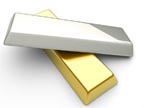 London: The decades-old methods for determining the daily benchmark prices for gold and silver seem set to change—the result of unwelcome attention from regulators and class-action lawsuits.
London: The decades-old methods for determining the daily benchmark prices for gold and silver seem set to change—the result of unwelcome attention from regulators and class-action lawsuits.
Currently, the price of both metals is set at a daily teleconference by a number of prominent multinational banks—four in the case of gold, and three in the case of silver.
However, the 117-year-old silver price-setting mechanism will end on Aug. 14, after participant Deutsche Bank announced its intention to quit the process, leaving two banks, according to The Financial Times.
The London Bullion Marketing Association said in a statement it is evaluating proposals for a new method, and several proposals will use electronic tools.
Similarly, the World Gold Council has called for a new way to determine the daily price of the yellow metal, decrying the current price-setting method, which dates back to 1919, as outdated and in need of reform.
Several class-action lawsuits and international regulators are targeting the gold price-setting method, with critics charging it’s non-transparent and open to manipulation. In April, Deutsche Bank quit this mechanism as well, leaving four banks, instead of the traditional five.
“What was appropriate 100 years ago isn’t appropriate today,” says Natalie Dempster, managing director of central banks and public policy at the World Gold Council, the London-based group that represents gold miners. “We didn’t have computers 100 years ago.”
She notes that the current method doesn’t meet the criteria set out last year by the International Organization of Securities Commissions for determining financial benchmarks.
“The fix needs to be reformed one way or another,” Dempster says, particularly in the area of transparency and a lack of oversight.
She adds that “there are some elements of the fix that perform well,” particularly the fact that it is based on actual trades.
But the WGC has said that a new fix should have these five characteristics: The new benchmark price should be based on executed trades, rather than quote submissions; it should be a tradable price, not simply a reference one; the input data should be highly transparent, published, and subject to audit; it should be calculated from a deep and liquid market, through which a significant volume of gold flows are transacted; and it should represent a physically deliverable price, as many users want to take physical delivery of gold.
The WGC has convened a meeting on July 7 in London, which will be attended by banks, miners, traders, and other interested parties, to discuss the issue. The U.K. Financial Conduct Authority will attend as an observer.




 By
By